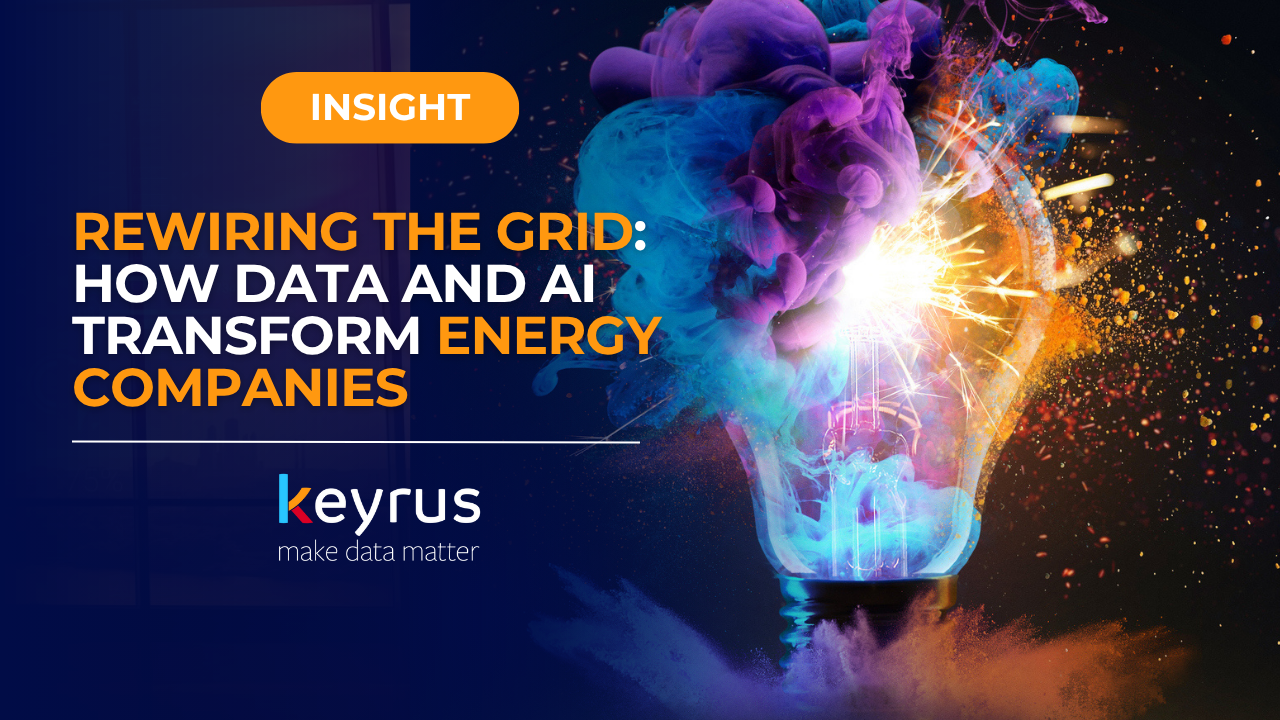The electricity sector stands at a critical crossroads. With renewables surging, prosumer models emerging, and aging infrastructure pushing up costs, electricity providers are navigating a new era of complexity.
Electricity companies are under strain to ensure stable and constant electricity supply, whilst adapting to modern energy consumption technologies and demand variability. Not to mention, remain competitive on pricing and retain customers in a market which now has high customer churn and intense tariff pressure.
The key to overcoming these challenges lies in what you can do with the data available (whether that be grid load data, customer energy consumption data, CRM or sales data) — and in implementing a clear, forward-looking data and AI strategy to turn that data into actionable intelligence.
The growing challenges in electricity distribution
Electricity distribution networks were originally designed for one-way power flows, predictable demand, and centralised generation. Today’s reality looks very different. Electricity companies face a combination of technical, operational, and strategic challenges:
1. Aging infrastructure & deferred maintenance
Many electricity distribution infrastructures — transformers, substations, overhead power lines— are decades old. Without predictive insights, failures often occur unexpectedly, leading to costly emergency repairs, power service interruptions, and safety risks.
2. Demand volatility and electrification
The rapid adoption of electric vehicles, heat pumps, and other electric technologies is transforming consumption patterns. Load peaks are becoming harder to predict, straining the grid’s capacity and planning processes.
3. Integration of renewables & bidirectional flows
Distributed solar and storage introduce two-way power flows. This creates new stability and control challenges, as traditional grids were built for centralised, one-directional energy movement. On top of this, demand is increasing for prosumer business models however this requires upgrading infrastructures as well as tariff models.
4. Regulatory & tariff pressures
Regulators expect fair pricing and reliability. Meanwhile, electricity companies need to optimise tariffs and business models to remain financially sustainable in competitive markets.
5. Data silos & lack of real-time insight
Many electricity companies struggle with fragmented systems (load network, CRM, billing), that don’t communicate effectively. Without integrated data platforms, decision-making is slow, reactive, and often incomplete, leading to missed business opportunities and revenue sources (eg. Revenue leakages from missed up-selling opportunities of home smart metres or solar panel installations).
6. Climate change & resilience needs
Extreme weather events are becoming more frequent. Electricity companies must be able to forecast, prepare for, and rapidly respond to disruptions, which requires better data visibility and predictive capabilities.
Why data and AI strategy is the missing link

Data alone doesn’t deliver value — strategy does. Its what you do with your data which will help you remain competitive in the electricity provider market. AI can be an accelerator of this data transformation: data feeds AI, AI feeds data. However, many companies starting their AI journey realise their data is not AI-ready (read more on AI-ready data here), and therefore AI initiatives fail early in the journey. But ignoring the AI wave means being left behind, which is not an option. This is why a robust data and AI strategy is the key to ensuring business continuity.
A well-defined data and AI strategy aligns business objectives, technology architecture, operational processes and governance. Results? Valuable decision intelligence to reduce power outages, optimise maintenance costs, unlock new revenue prosumer or renewable energy technology streams.
Here’s how:
1. Turning electricity data into predictive power

Rather than relying on historical averages, AI models can analyse real-time and historical data from grid assets, weather patterns, and energy consumption behaviour to:
Forecast electricity demand with greater accuracy, enabling smarter load balancing. AI can forecast and smooth load curves by anticipating peaks and adjusting grid configurations dynamically.
Detect anomalies early, preventing power outages before they occur.
Prioritise power line and power station maintenance based on risk level of breakdowns rather than routine schedules.
Resilience Modelling: AI can simulate extreme weather events to identify weak points in the grid and optimise investment in hardening infrastructure.
For example, predictive maintenance algorithms can analyse transformer temperature trends, switching patterns, and environmental data to flag assets at risk of failure — weeks in advance.
2. Building a modern data architecture
Many electricity companies still rely on siloed, on-premise platforms that make data integration and analytics difficult.
A modern data architecture creates a single source of truth by consolidating electricity and consumer data from multiple systems (e.g., grid data platforms, GIS, CRM, sales databases) into a unified, governed platform. This enables:
Real-time operational dashboards
Interoperability across departments and applications
Easier compliance with regulatory data reporting
Decision intelligence capabilities
3. Ensuring electricity supply stability
By tapping into this real-time data from smart meters, grid sensors, and weather forecasts, electricity companies can see what’s happening across the network the moment it happens. Machine learning steps in to balance variable solar and wind generation with changing consumption patterns, fine-tuning the flow of electricity so the grid stays steady. Resulting in:
Fewer voltage swings, fewer unexpected outages, and a smoother experience for everyone
Satisfied customers and stable power supplies, even when the weather or demand takes a sudden turn.
4. Unlocking new business models
Once electricity and business data is unified, electricity companies can move beyond core operations to explore new value streams:
Offering energy optimisation services to industrial and commercial customers.
Enabling peer-to-peer electricity trading between prosumers.
Launching dynamic, usage-based pricing models. By analysing usage patterns, AI models can simulate and optimise tariff structures to incentivise load shifting and enhance revenue.
This shift from a traditional electricity network to a data-driven electricity service provider is essential for long-term competitiveness.
Where to get started: An actionable roadmap to data and AI strategy

Many electricity companies hesitate because they see AI as complex or futuristic, not to mention wrong investment decisions can lead quickly to high costs – especially with cloud cost control being the biggest danger of AI initatives, or data that is not AI ready can often block the transformation. In reality, the path to AI transformation is achievable and Keyrus can help. Our data & AI strategy advisory service works with electricity companies to:
Envision, Assess & Analyse:
Collecting your business objectives & requirements
Evaluating your current data capabilities
Conducting a data & AI maturity assessment to identify gaps, and strategic priorities.
Evaluate & blueprint:
Evaluating all possible technology and architecture alternatives & measure their feasibility
Selecting and designing the target data architecture and technology, and define governance frameworks.
Prioritise & plan:
Building a performance priority plot to advise on the next steps to take for immediate added value as well as where to go in the future
Providing and implementation plan & timing estimates to give a concrete action plan.
The electricity grid of the future will be intelligent, adaptive, and resilient. Electricity companies that embrace their data and implement a strategic, structured data and AI strategy will be better equipped to navigate the energy market transition — and to lead it.
From predictive maintenance to dynamic pricing and renewable energy integration, the opportunities are significant. But success requires more than technology: it demands vision, the right technology, an action plan, and governance. Take the step > Contact Keyrus for an advisory consultation on how you can get started.
